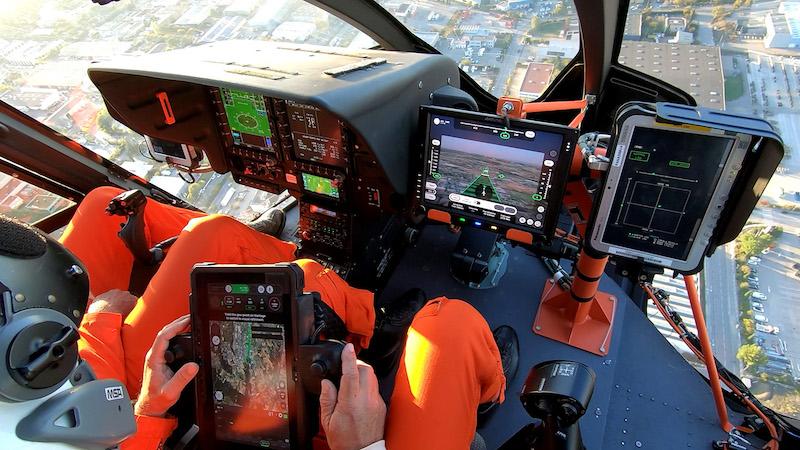
Airbus Helicopters has completed initial flight tests of an autonomous rotorcraft flight control system that can be controlled entirely through a tablet computer.
The OEM’s three-year Vertex project—supported by Airbus’ UpNext innovation arm and jointly funded by France’s Civil Aviation Authority—has demonstrated fully autonomous flight, including takeoff, cruise, approach and landing.
The efforts are initially focused around improving safety in light helicopter operations, as well as paving the way toward autonomous operation of electric advanced air mobility systems.
“The goal of the demonstrator was to show how we can simplify the mission from the preparation to control, reducing the workload and increasing safety and the autonomy of the helicopter,” Alexandre Gierczynski, program lead for the Vertex project, tells Aerospace Daily.
Flight testing has been performed with Airbus Helicopters FlightLab H130 technology demonstrator aircraft. The same aircraft has recently been used to demonstrate control of the helicopter using a single stick—replacing the cyclic, collective and pedal inputs/controls.
To enable Vertex, the aircraft is equipped with a four-axis autopilot, a gimbaled electro-optical camera and Light Detection and Ranging (Lidar) sensor, connected to a high-power onboard computer.
The primary interface for the pilot is a tablet computer and a small flight information display fitted in front of the pilot. As part of Vertex’s development, engineers designed an entirely new human-machine interface, with basic flight information including altitude, track and speed overlaid on synthetic terrain provided through a database.
On the tablet, a series of contextual buttons changes depending on the mission profile. The use of the Lidar provides information on potential obstacles, such as electric wires, and supports a collision-avoidance capability. The gimbal camera allows the pilot to identify potential landing zones and can cue the control system to perform an approach into that landing zone, advancing the company’s internally developed Eye for Augmented Guidance for Landing Extension (EAGLE) system.
Whenever necessary, the pilot can easily override the controls through the tablet and resume the mission afterward.
The system also leans on the four-axis autopilot to provide a level of flight envelope protection, while the engines are also managed by the autopilot.
Combined with highly accurate navigation systems, the autopilot also enables operation in confined areas, such as automated hover taxiing at airports.
During the flights between Marseille-Provence International Airport and the nearby Aix-en-Provence airfield using pre-defined routes, the system would keep the helicopter hover taxiing at the airports constantly within a corridor just 2 m (6 ft.) wide, Gierczynski says.
Other systems developed include what Gierczynski calls a “smart radio,” which changes radio frequency communication to the most likely required frequencies depending on the location of the aircraft.
“Radio management in a very dense area can represent up to 8% of the pilot workload,” Gierczynski says. Instead, the smart radio “pre-selects frequencies … and automatically switches to those you have to use in that region.”
Engineers also added a function that would enable an emergency landing, with the system proposing areas to make a safe landing—which is then validated by the pilot.
First flights with the Vertex system began in July, although the system was initially flown uncoupled to the autopilot. The first coupled flights took place in September, and test pilots have since completed around 15 hr. of coupled flights, with the most recent taking place Nov. 22.
“We believe we had a mature product after seven hours of flight,” Gierczynski says. The system has now been taken to a technology readiness level of around four, he says—ready for further exploitation where the OEM sees fit.
Vertex was the first Airbus Helicopters program supported by the UpNext organization, which aims to accelerate technology development by funding demonstrators.
“This successful demonstration of a fully autonomous flight from takeoff to landing is a great step toward the reduced pilot workload and simplified human-machine interface that the Airbus Urban Air Mobility team intends to implement on CityAirbus NextGen,” says Michael Augello, CEO of Airbus UpNext.
Airbus Helicopters says it will now continue to mature different technologies to support and further enhance Vertex, including vision-based sensors and algorithms for situational awareness and obstacle detection; a fly-by-wire for enhanced autopilot; and a head-worn display for in-flight monitoring and control.
